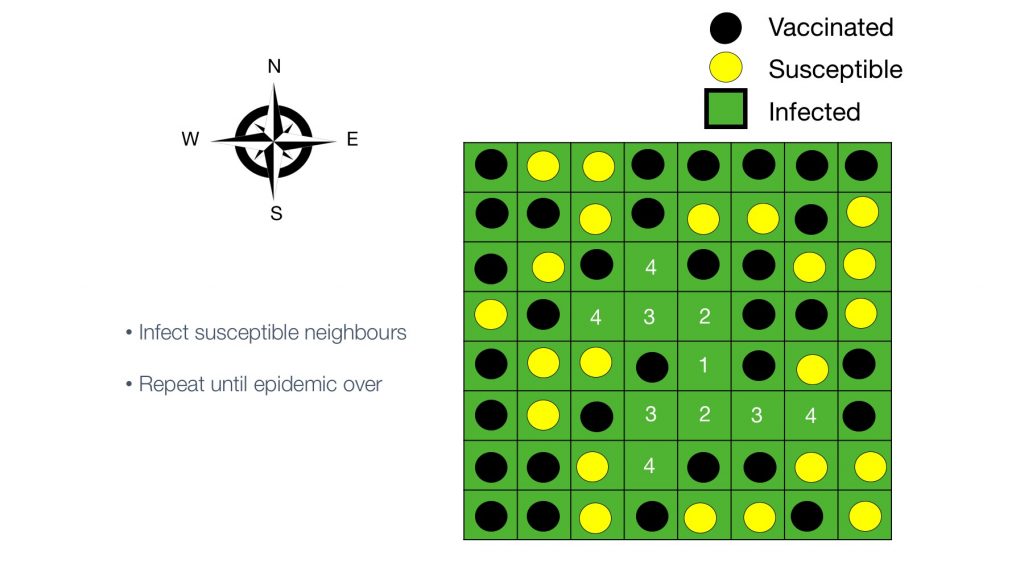5th July
For the last of the three main learning activities, we focussed on the very topical concepts of vaccines and herd immunity. We used an activity that was deemed a bit ‘experimental’ by our IoE experts, especially for this age group. Note that we had conceived and designed this lesson in 2019 well-before the pandemic, so it felt a bit eerie to be delivering it smack in the middle of a devastating pandemic and historical vaccine rollout. This most certainly contributed to the children’s interest in the topic and the nature of their questions, so it would be interesting to see how/if this changes as society moves on from the pandemic in future years.
For this one, we decided it was best to visit the school in person as it involved a ‘game’ on human-sized chess mats to be played outside. (Logistically difficult to observe remotely through Teams on an ipad!) It was such a blast to interact with the kids face-to-face. More children spoke up to me in person than they did via Teams on the class ipad. (In the remote sessions, it tended to be the same children coming up to ask questions.)
Activity Summary
The ‘game’ is meant to simulate an outbreak of an infectious disease and our main learning objective for this age group was to demonstrate that vaccines protect yourself and others. It works as follows. The children arrange themselves on squares of the chess mat as close together as possible. Some wear football bibs (vaccinated) and others do not (susceptible). Start off with a ratio of 50-50, which roughly simulates the target vaccination rate for influenza. In our case the football bibs were in ‘quarantine’, so the kids did jumper/no jumper instead.
A random susceptible player is chosen to become ‘infected’. Children directly next to the first infected person then also becomes infected and so forth. Vaccinated people are protected such that the epidemic will spread until there are no longer any infected individuals next to any susceptible individuals, and the epidemic ends. Final numbers/percentages of infected, vaccinated, and susceptible but protected people can then be calculated.

Variations include: vary the starting ratio of vaccinated/susceptible (i.e., vary the vaccination rate); vary the arrangement of vaccinated/susceptible on the board (i.e., social distancing vs close crowds); allow people on ‘diagonals’ to also become infected (i.e. simulates a higher R value, such as measles).
Reflections
The activity was successful in that the children were very engaged and interested in vaccines, given it is very topical. This elicited a lot of good and sophisticated questions, especially from some of the quieter girls. The learning objective that ‘vaccines protect yourself and others’ seemed to get through to most of the students. They seemed to have fun and left the exercise with a positive attitude about vaccines!
On the flip side, it certainly wasn’t perfect, revealing the ‘experimental’ nature of the activity. The children didn’t want to stand side-by-side in an organised cluster, and were snaked around the board too much, with too much empty space between small groups of them (girls on one side, boys on another!). This meant that when the epidemic ‘started’ it would usually end straight away after only being passed on to a few other students. However, we were able to turn this into part of the learning scenario by demonstrating that their arrangement was akin to ‘social distancing’ or ‘isolating’. Running 3 groups at same time meant that the children were getting bored and unfocussed, especially since we only had one microbiology expert to go around all three groups. The outdoor setting and languished time from running 3 groups simultaneously wasn’t conducive for doing any of the maths ‘bonuses’ like calculating percent immunised, percent infected etc. Lastly, teaching the concept of herd immunity was difficult. I don’t think they had misconceptions/preconceptions about herd immunity (a potential concern across society more generally), but rather they just didn’t really get it or seem to care. The link between the term ‘herd immunity’ and the objective that ‘vaccines protect yourself and others’ seemed to be lost.
Some of the above weaknesses could probably be attributed to the age group (which was 10 and some 11 year olds)… the outdoor game inspired a lot of jumpy-ness (lack of ability to stand still), yet I was impressed that despite this, they were still focused on the concept of vaccines. And the concept of herd immunity was probably too advanced for the age group. I think the activity would also work well for slightly older children, but in this case, I would recommend doing it in pairs of students using regular sized chess/draughts board with coloured playing pieces. This would allow them to calculate the ratios and really see ‘quantitatively’ how herd immunity works for viruses with higher/lower R-numbers. Plus, I don’t think children any older would fit on the life-sized chess mat!
Interestingly, many of their questions (see below) suggested that they would take the COVID vaccine if offered. I wonder if I should have finished the activity by asking them to raise their hand if they would get the vaccine. However, I was a bit hesitant to push too far in this direction, as I’m still unsure if there is an ethical issue here and wanted to avoid any impression of coercion. I was also surprised (and relieved) at how generally positive they seemed with this activity. Given all that they and their families, friends, and teachers have been through over the last ~15 months, I was initially worried that some would be fearful or upset in discussing this topic. But not so! Some very resilient and inquisitive kids indeed.
Notable questions related to vaccines:
- How do vaccines work?
- What are antibodies?
- Is there a vaccine for cancer?
- Is the vaccine safe for pregnant people?
- Can the vaccine give you COVID?
- Can I get the vaccine when I’m about to turn 18?
- Will they give it to us when we become teenagers?
- If my parents and others in my family are vaccinated for COVID does that mean I won’t be able to catch it?

